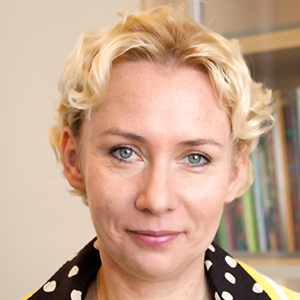 Arnsten is a member of the National Academy of Medicine. Her work has led to treatment for ADHD and other conditions with roots in the prefrontal cortex. (Photo courtesy of Amy Arnsten)
Arnsten is a member of the National Academy of Medicine. Her work has led to treatment for ADHD and other conditions with roots in the prefrontal cortex. (Photo courtesy of Amy Arnsten)During her NIEHS Martin Rodbell Lecture on June 14, Amy Arnsten, Ph.D., from the Yale School of Medicine, discussed pandemic stress and a new treatment for cognitive deficits that result from long COVID-19. She also shared her groundbreaking research on norepinephrine (NE), a hormone and transmitter that sends signals to muscles or cells to provoke action.
Arnsten drew attention to the significant role that NE plays in brain circuits that govern higher cognitive function, such as abstract reasoning and top-down control of attention, actions, and emotions. She highlighted how NE affects circuits in the prefrontal cortex (PFC), which is the area of the brain that governs higher cognition.
Moderate levels of NE are essential to PFC function through alpha-2A-adrenoceptors, which are cells or groups of cells that receive information from stimuli. They play a critical role in brain and nerve regulation, thereby strengthening PFC connections. However, high levels of NE released during stress impair PFC function and switch control of behavior to more primitive circuits such as the amygdala, a brain area associated with emotion. The amygdala, in turn, can activate the striatum, a neural region that controls habitual responses, Arnsten noted.
This switch can save our lives when we are cut off on the highway, but it can be harmful when we face complex or invisible threats, such as climate change or COVID-19, and need our PFC to survive, she told attendees.
Addressing stress and mental health
“When I was asked in 2021 to nominate speakers for this year’s Rodbell Lecture, I was working from home and feeling stressed from the pandemic and the ongoing political and social turmoil in our country,” observed NIEHS scientist Patricia Jensen, Ph.D., who hosted the lecture.
Jensen is a senior investigator leading the institute’s Developmental Neurobiology Group, and she is currently conducting research into how environmental toxicants affect NE during brain development. Jensen published 2019 work on norepinephrine as well.
“Pondering the impact of these combined factors on our mental health and well-being, I recalled Dr. Arnsten’s ongoing research,” said Jensen.
Research advances treatment
Arnsten has spent two decades researching the effects of stress on the brain. Her work has shown that PFC circuits are uniquely regulated at the molecular level. This can cause vulnerability in mental illness and age-related cognitive disorders such as Alzheimer’s disease.
Studies in her lab led to the discovery that the medication guanfacine can treat impairment of mental processes associated with attention deficit hyperactivity disorder (ADHD) and related prefrontal cortex disorders. Guanfacine is an alpha-2A-adrenoceptor agonist, which is a type of drug that selectively stimulates certain receptors in the brain and spinal cord. Traditionally used to treat high blood pressure, the medication strengthens connectivity and improves firing of PFC circuits.
As a result of Arnsten’s research, guanfacine has also been used to treat post-traumatic stress disorder, traumatic brain injury, and delirium. More recently, guanfacine has been used to treat cognitive deficits associated with long COVID-19, Arnsten noted.
“Research on stress effects in the prefrontal cortex of the brain is very timely to our times in the pandemic,” Arnsten said in a 2021 talk. Also, in response to pandemic tension, Arnsten posted a video titled “How our brains react to uncontrollable stress” on the Yale School of Medicine YouTube channel.
Supporting one another
“Just knowing what this mechanism [the functioning of NE in the prefrontal cortex] is and having the ability to say, ‘Oh, I can take a breath. I understand what's going on’ — I think that makes a tremendous difference,” Jensen observed during the Rodbell Lecture Q&A session.
Also, whether NE causes stress can depend on your confidence level in a task, Arnsten noted. “If you think you’re a good public speaker, like Bill Clinton, stress signaling events are not initiated. But if you feel that you have no control over a situation, the brain activates these events. Supporting each other can help us feel more in control and be our better selves.”
Citation: Chen Y-W, Das M, Oyarzabal EA, Cheng Q, Plummer NW, Smith KG, Jones GK, Malawsky D, Yakel JL, Shih Y-T I, Jensen P. 2019. Genetic identification of a population of noradrenergic neurons implicated in attenuation of stress-related responses. Mol Psychiatry 24(5):710−725.
(Catherine Arnold is a contract writer for the NIEHS Office of Communications and Public Liaison.)









